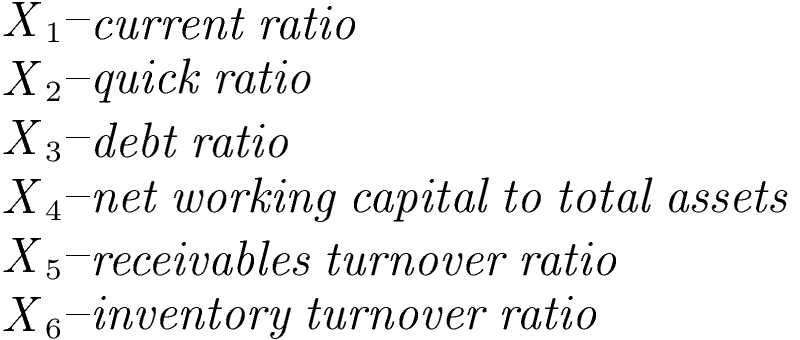D. Hadasik's model (1998)
Method of calculation

where:

Model description
D. Hadasik developed 9 versions of discriminant models. However, model No 4 (from 1998) is considered as the most relevant, due to its high fit. The model consists of 6 financial ratios that refer to financial liquidity, indebtedness and the efficiency of operating performance.
Interpretation of the Z(HA)-score
- Z(HA) = -0.374345 - critical value (bankruptcy threat for the function below the critical value)
- Z(HA) ≤ -0.374345 - "bankrupt" (distress zone)
- Z(HA) > -0.374345 - "non-bankrupt" (safe zone)
- Model fit: 95.08% (the model correctly classified 95.08% of the examined companies).
- The higher is the Z(HA) function (above -0.374345), the better is the financial situation of a company and the lower is the bankruptcy threat within the forthcoming year.
- The increase of Z(HA) over time indicates the improvement of financial situation and decrease of bankruptcy threat.
- In the case of the Z(HA) < -0.374345 (which signalizes bankruptcy threat) it is recommended to run a detailed analysis of financial performance to detect which aspects require an immediate healing procedures.
Detailed description of respective ratios and their impact on the Z(HA)-score value
Constant value +2.36261
The constant, free factor results from statistical estimates when building the model, it allows setting the limit value of Z(HA).
X1 – current ratio
Method of calculation

Ratio's weight: +0.365425
Units: times
Remarks
The ratio is calculated like the current ratio available in the eanaliza.pl system in the group of liquidity ratios. It uses the data for the current period.
Ratio's interpretation
- A higher value of the ratio means a higher level of liquidity and better financial situation, which reduces the risk of bankruptcy.
- In the model, the X1 ratio has a weight with a positive sign, which means that increase in the ratio, will increase the Z(HA) function, reducing the bankruptcy risk.
X2 – quick ratio
Method of calculation

Ratio's weight: -0.765526
Units: times
Remarks
The ratio is calculated like the quick ratio available in the eanaliza.pl system in the group of liquidity ratios. It uses the data for the current period.
Ratio's interpretation
- A higher value of the ratio means a higher level of liquidity and better financial situation, which reduces the risk of bankruptcy.
- However, in this model, ratio X2 has a weight with a negative sign, which means that when the quick ratio increases, the Z(HA) function decreases, indicating higher level of bankruptcy risk.
X3 – debt ratio
Method of calculation

Ratio's weight: -2.40435
Units: %
Remarks
The ratio is calculated like the debt ratio available in the eanaliza.pl system in the group of debt management ratios. It uses the data for the current period.
Ratio's interpretation
- A higher value of the ratio means higher indebtedness of the company, which increases the risk of bankruptcy.
- In the model, the ratio X3 has a weight with a negative sign, which means that an increase in the ratio (thus an increase in debt) will lower the value of the function Z(HA), indicating higher bankruptcy threat.
X4 – net working capital to total assets
Method of calculation

Ratio's weight: +1.59079
Units: %
Remarks
The ratio is partially calculated like the net working capital to current assets available in the group of liquidity ratios, but in the denominator we take the total assets instead of the current assets. It uses the data for the current period.
Ratio's interpretation
- A higher value of the ratio means higher level of net working capital in financing assets, which improves firm's stability, financial liquidity and long-term solvency.
- Higher level of net working capital reduces the bankruptcy risk, by reducing the level of short-term liabilities .
- Increase in ratio X4, leads to increase in the Z(HA) function, improving the financial situation and safety of a company.
- In case of negative net working capital, negative value of X4 ratio will decrease the level of Z(HA) function, increasing the bankruptcy threat.
X5 – receivables turnover ratio
Method of calculation

Ratio's weight: +0.00230258
Unit: days
Remarks
The ratio is calculated like the receivables turnover ratio available in the eanaliza.pl system in the group of efficiency ratios. It uses the data for the current period.
Ratio's interpretation
- A higher value of the X5 ratio means a longer collection period of receivables, which limits the efficiency of operations.
- However, in the model, the X5 ratio has a weight with positive sign, which means that an increase in the ratio will lead to an increase in the value of the Z (HA) function and an improvement in the company's situation.
X6 – inventory turnover ratio
Method of calculation

Ratio's weight: -0.0127826
Unit: days
Remarks
The ratio is calculated like the inventory turnover ratio available in the eanaliza.pl system in the group of efficiency ratios. It uses the data for the current period.
Ratio's interpretation
- A higher value of the X6 ratio means a longer period of engaging funds in inventory, which reduces the efficiency of operations.
- In the model, the X6 ratio has a weight with a negative sign, which means that an increase in ratio will lead to a decrease in the value of the Z (HA) function, which in turn will indicate an increase in the risk of bankruptcy.
Based on:
HADASIK D. (1998). Upadłość przedsiębiorstw w Polsce i metody jej prognozowania, Akademia Ekonomiczna w Poznaniu, Poznań.
PRUSAK B. (2005). Nowoczesne metody prognozowania zagrożenia finansowego przedsiębiorstw, Difin, Warszawa.

